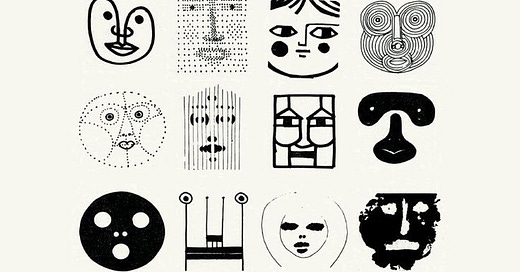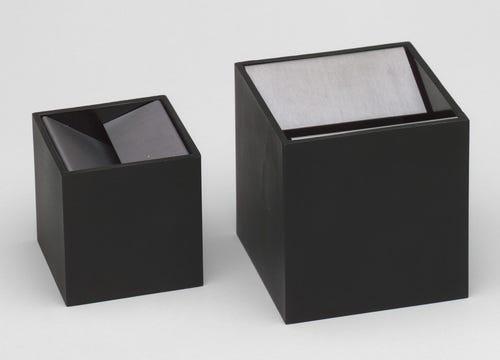Hey everyone. I apologize if you read the introduction to the last newsletter. Spring is not here yet. As temperatures sink back down below freezing alongside Montreal’s collective spirit, I’ve been spending a lot of time reading and hanging out. Yes, that’s what I already do, but it’s not the same when it’s sleeting outside.
I tore through Bruno Munari’s excellent Design as Art this past week. It’s a mix of essays and design philosophy from the Italian artist-turned-designer, so I’ll get into that. I was also finally able to catch Dune: Part Two. The review strayed longer than expected, so it’ll get the full treatment soon.
But in other news, I got a new film criticism gig and was accepted into grad school(s)! I imagine this newsletter was the sole contributing factor to both of these things. I am considering starting a GoFundMe to pay for tuition.
Bruno Munari
Bruno Munari’s name is one that I would always hear in passing. I knew almost nothing about him or his work until last week. Walking through the highly curated bookstore a couple of blocks from my apartment (the lady who runs it reads everything that comes through, selling only the best), I saw that name again. A slightly larger than pocket-sized text whose cover stared at me with about a dozen faces bearing a dozen different styles, it exemplified Munari’s most famous quote: “Art shall not be separated from life: Things that are good to look at, and bad to be used, should not exist.”
Design as Art is good to look at and feels good to use. Resting comfortably in the reader’s hands at a manageable size and filled with sketches to explain his theories better, Munari’s text is the most accessible and enjoyable book on art theory I have read to date. And somehow, despite his strangely prescient preachings on the deification of individual artists, the importance of typefaces, and vaguely utilitarian aesthetics, there is one thing that he understands best: fun.
Born in Milan in 1907, Munari was a multi-hyphenate whose biggest success was found in design. He began his career as an engineer under his uncle, before transitioning to fine art alongside other Second Italian Futurist Movement students. Given the rise of fascism in pre-WW2 Italy, he would later abandon Futurism altogether. He dabbled in writing children's books, filmmaking, painting, sculpture, and installation art.
The beginning of Munari’s capital-A art career was marked by a tongue-in-cheek series he dubbed Useless Machines. Each machine - a mobile built from materials that would decay over time and designed in a likeness similar to those of Alexander Calder - would hang from the ceiling and spin slowly. In Design as Art’s introduction, Munari uses his debut as a launchpad to introduce his design philosophy. “They are useless because unlike other machines they do not produce goods for material consumption, they do not eliminate labour, nor do they increase capital,” he contends. But “they were extremely useful because they provided goods of a spiritual kind (images, aesthetic sense, the cultivation of taste…)” These two beliefs are paramount to his design philosophy. Even though the object may not produce goods directly or eliminate labour, his design philosophy allowed it to resonate with its user on the wavelength of beauty.
Years later, Munari would define his ‘machines’ as “pure art,” instead of fine art, and his products as “applied art,” instead of commercial art. By taking on these alternative terms, he enabled himself to view almost every manufactured object as a work of art. His Useless Machines were no less art than Zizi, the malleable toy monkey he designed (the monkey in question caused a scandal when it won the Compasso d’Oro, one of the highest design awards in Italy). For Munari, aesthetic beauty existed in every object, and beauty was a byproduct of practicality. Zizi is beautiful not just because he’s a cute little guy, but because he is personalizable, malleable, and stimulating to children. He’s beautiful because he’s fun. Beauty emerges through interaction, not observation.
Following this line of thought, designers are responsible for our well-being to Munari. In the book’s first chapter, he writes, “When the objects we use every day and the surroundings we live in have themselves become a work of art, then we shall be able to say that we have achieved a life well balanced.” But what makes a fork a work of art? Or a car?
“What is a car, if not a piece of travelling sculpture?” Munari contends. A Cybertruck owner may not have the vocabulary - or the critical thinking skills - to concur with this statement, but looking at Tesla’s clientele, they’re definitely approaching their new wheels in the same way someone looks at the art that they love. We all do this unconsciously, and Munari calls his readers to engage with their own objects consciously. This deliberate interaction shapes all of his “applied art,” perhaps best in his most iconic work.
A half-century before the dawn of Rick & Morty rolling trays and other holographic smoking paraphernalia, Munari designed the Cubo Ashtray. Made for Danese Milano in 1957, it’s a small-ish cube with its top split into two halves, each bent slightly downwards. One is positioned at a steeper slope than the other, slightly overlapping it and leaving a small gap in the middle for the ash to fall into. A simple machine that does not remove labour - the cube needs to be emptied just like any other ashtray - it instead creates spiritual goods. Unlike the typical plate-shaped ashtray or deepened bowl, the Cubo hides the ashes, leaving only the best parts of smoking without the worry of cleanup, or the possibly unsightly image of a pile of ash. “Just as long as we don’t see it, why worry?” Munari writes about dirt and detritus. The Cubo Ashtray lets its users smoke in peace, giving them a little show as they watch their cigarette’s ashes slide down a couple of ramps not unlike sliding a letter into a postbox.
Released in a variety of colours and sizes, Munari lets the consumer (or art enjoyer) choose the most beautiful option. To someone who hosts a lot and for whom smoking is a communal act, a larger Cubo would serve them best, with the ashtray serving as both a tray and a central talking point. For someone who reads while smoking alone, a smaller Cubo would be the most beautiful. The Cubo is just an ashtray — a useful object. By that qualification alone, it is beautiful.
A lot of the objects we amass in our homes are beautiful. They are beautiful not only in the aesthetic sense but also in our interactions with them on a day-to-day basis. We might find them useful, fun, or beautiful for some reason that we aren’t yet aware of. As Munari says, “It is ‘beautiful’ because it is just right.”





